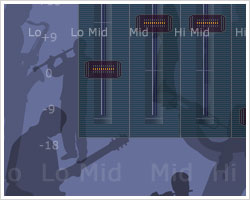Equalization is used to adjust the sound of an instrument so that certain frequencies are either accentuated or reduced. This is useful in both recording and live performance, and some form of equalizer (EQ) unit is used by all audio engineers. By adjusting its EQ, the engineer can change the timbre of an instrument, causing it to stand out prominently or pushing it into the background.
EQ units are also used to balance out peculiarities in the acoustics of a particular room or hall, especially in live settings. The simplest kind of equalizer is a tone control which adjusts the bass (low frequecies) or treble (high frequencies) of the audio signal. A typical graphic equalizer has slider controls for at least 5 frequency ranges (bands), allowing the gain for each frequency range to be boosted or cut. Many instrumentalists - especially guitarists and bassists - use graphic equalizer pedals among their effects in order to get better control over their tone.
See also: Equalization (Wikipedia)
EQ Match will train your ear to hear the different frequencies on a 5-band graphic equalizer, using a wide variety of instrument samples.

